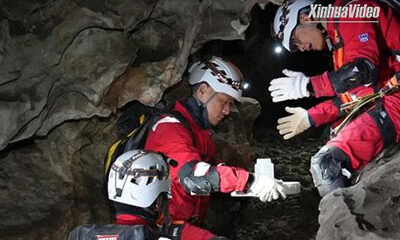China
Chang’e-5 မှ ပြန်လည်သယ်ဆောင်လာသော လမျက်နှာပြင်နမူနာပစ္စည်းများက လပေါ်တွင်တွေ့ခဲ့ဖူးသမျှတွင် အသေးငယ်ဆုံးကျောက်တုံးများဖြစ်နေ

ဆစ်ဒနီ၊ အောက်တိုဘာ ၈ ရက် (ဆင်ဟွာ)
တရုတ်နိုင်ငံ၏ Chang’e-5 အာကာသယာဉ်က လမျက်နှာပြင်ပေါ်မှ စုဆောင်းလာခဲ့သော မီးတောင်ချော်နက် မီးသင့်ကျောက်များသည် သက်တမ်းအားဖြင့် နှစ်ပေါင်း ၂ ဘီလီယံခန့် ရှိပြီဖြစ်ကြောင်း၊ လမျက်နှာပြင်ပေါ်တွင် အသေးငယ်ဆုံး မီးသင့်ကျောက်များဖြစ်ကြောင်း အောက်တိုဘာ ၈ ရက်၌ ထုတ်ပြန်သော သိပ္ပံဂျာနယ်တွင် နိုင်ငံတကာသုတေသနအရ သိရသည်။
သုတေသနကို ဦးဆောင်ရေးသားသူ ဩစတြေးလျနိုင်ငံ Curtin တက္ကသိုလ်ရှိ အာကာသ သိပ္ပံနှင့် နည်းပညာစင်တာမှ ပါမောက္ခ Alexander Nemchin က ကြီးမားသည့်ရောင်စဉ်တိုင်းကိရိယာများ အသုံးပြုလျက် ပေကျင်း ဓာတ်ခွဲခန်းနှင့် သီးခြားအစည်းအဝေးများအတွင်း လမျက်နှာပြင်မှ ကျောက်တုံးနမူနာများ၏ သက်တမ်းကို ဆုံးဖြတ်ခဲ့ကြခြင်းဖြစ်ကြောင်း ပြောကြားခဲ့သည်။
ကျောက်တုံးနမူနာများအား ၂၀၂၀ ပြည့်နှစ် ဒီဇင်ဘာလက Chang’e-5 လကမ္ဘာခရီးစဉ်အတွင်း စုဆောင်းရယူခဲ့ခြင်း ဖြစ်ပြီး ၁၉၇၆ ခုနှစ်မှစ၍ လကမ္ဘာမှ ကျောက်တုံးများစုဆောင်းခဲ့သည့် မည်သည့်နိုင်ငံနှင့်မဆို ပထမဆုံးအကြိမ်လည်း ဖြစ်သည်။
ကျောက်များ၏ ဓာတုဗေဒကို ခွဲခြမ်းလေ့လာပြီးနောက် နမူနာများသည် လကမ္ဘာပေါ်တွင် ယခင်တွေ့ရှိခဲ့သော ကျောက်တုံးများထက် သက်တမ်း နှစ် ၁ ဘီလီယံ ပို၍နုသည်ကို တွေ့ရှိခဲ့ရကြောင်း Nemchin က ပြောကြားခဲ့သည်။
ရလဒ်အသစ်များသည် မီးတောင်ဝဖြစ်စဉ်၏ ပြွန်ဝအမှတ်အသားများ တွက်ချက်ခြင်း၊ ကမ္ဘာ့လေထုမျက်နှာပြင်များစွာ ပိုမိုမှန်ကန်၍ သက်တမ်းမြင့်မားမှု အရင်းအမြစ်ရရှိစေခြင်း စသည်တို့နှင့်အတူ သုတေသီများအား ပံ့ပိုးပေးနိုင်မည်ဖြစ်ကြောင်း Curtin ၏ အာကာသသိပ္ပံနှင့် နည်းပညာစင်တာမှ သုတေသနစာတမ်း ပူးတွဲရေးသားသူ ပါမောက္ခ Gretchen Benedix က ပြောကြားခဲ့သည်။
“ဒီရလဒ်တွေက သီးခြားရရှိထားတဲ့ လရဲ့ ဓာတ်ပုံတွေအပေါ် အခြေခံပြီး ကာလရှည်ခန့်မှန်းထားတာတွေကို အတည်ပြုပေးလိုက်တာဖြစ်ပြီး ဒီလို ငယ်ရွယ်တဲ့ မီးသင့်ကျောက်တွေ ဘာကြောင့်ရှိနေတာလဲဆိုတဲ့ နောက်ထပ်မေးခွန်းတွေလည်း ပေါ်ထွက်လာစေတယ်” ဟု Benedix က ပြောခဲ့သည်။
ယခုအခါ အဆိုပါ လုပ်ငန်းသည် အပူချိန် ၁,၀၀၀ ဒီဂရီစင်တီဂရိတ်ကျော်ရှိသော မီးတောင်ချော်ရည်ပူ ဖွဲ့စည်းမှုကို ပံ့ပိုးပေးနိုင်ဖွယ်ရှိသော မကြာသေးမီက လ၏အပူပေးစနစ်နှင့် မည်သို့ဆက်စပ်နေသည်ကို ရှင်းပြပေးနိုင်မည်ဖြစ်သလို ဆိုလာစနစ်တစ်ခုလုံး၏ သက်တမ်း တိုးတက်မှုက သုတေသီများအား ကူညီပေးနိုင်မည့် လုပ်ထုံးလုပ်နည်းတစ်ခုကို ရှာဖွေရန်အလှည့်ကျရောက်လာမည်ဖြစ်သည်။ (Xinhua)
…………………………………………
(English Version)
Lunar samples brought back by Chang’e-5 identified as youngest rocks ever found on the Moon
Source: Xinhua| 2021-10-08 12:06:24|Editor: huaxia
SYDNEY, Oct. 8 (Xinhua) — The basaltic volcanic rocks, collected as part of China’s Chang’e-5 probe from the Moon, were about 2 billion years old, marking the youngest volcanic rocks identified on the Moon so far, according to an international research published in the journal Science on Friday.
Professor Alexander Nemchin from Space Science and Technology Center of Australia’s Curtin University, lead author of the research, said researchers determined the age of the lunar rock samples during remote sessions with the Beijing laboratory using large mass spectrometers.
The rock samples were collected during the Chang’e-5 lunar mission in December 2020, which marked the first time any nation had collected rocks from the Moon since 1976.
Nemchin said after analyzing the chemistry of the rocks, they found the samples were 1 billion years younger than those rocks previously collected on the Moon.
Co-author Professor Gretchen Benedix, also from Curtin’s Space Science and Technology Center, said the new results would provide researchers with more calibration points for cratering chronology, enabling them to derive more accurate and higher resolution ages across many planetary surfaces.
“These results confirm what experts had long predicted based on remotely obtained images of the Moon and raise further questions as to why these young basalts exist,” Benedix said.
The task will now turn to finding a mechanism that will explain how this relatively recent heating of the Moon may have supported the formation of basaltic magmas with temperatures exceeding 1,000 degrees Celsius, and ultimately help researchers improve age dating of the entire Solar System. Enditem
Photo taken on Dec. 19, 2020 shows the container of lunar samples during the Chang’e-5 Lunar Samples Handover Ceremony at China National Space Administration in Beijing, capital of China. Moon samples collected by China’s Chang’e-5 probe have been transferred to the Chinese research teams Saturday morning. Scientists will carry out the storage, analysis and research of the country’s first samples collected from the extraterrestrial object. (Xinhua/Yue Yuewei)






